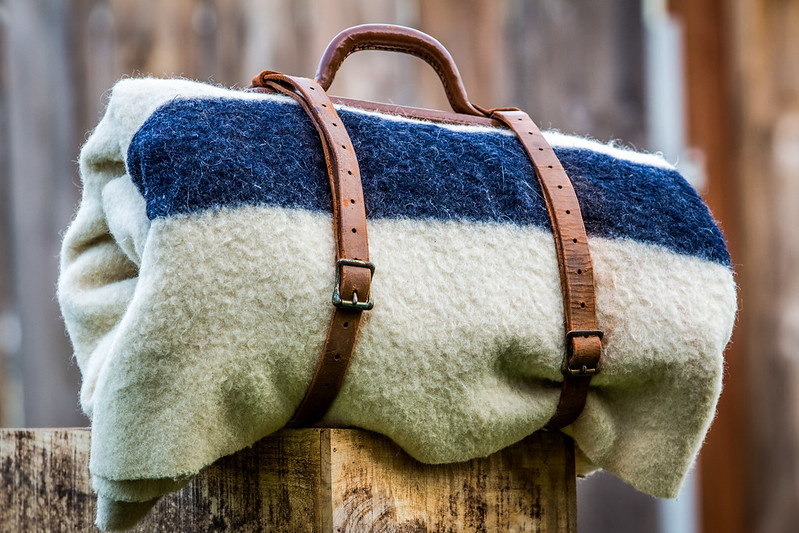Do you know how to spot a fake Hudson Bay blanket? If you live in North America, chances are that you’ve seen a Hudson Bay blanket at some point. It is a wool blanket designed with a series of stripes and points, commonly white with green, red, yellow, and indigo stripes.

How To Know If A Hudson Bay Blanket Is Fake
The Hudson Bay blanket may be a Canadian icon. However, unlike Tim Horton’s, one of these will set you back a couple of hundred dollars. You don’t have to worry about the price as it will last for generations — if you have an authentic one, that is.
Hudson Bay blankets are made of 100% wool and have an authenticity seal on one corner that indicates the year the Hudson’s Bay Company was incorporated: in 1670. The HBC authenticity label was explicitly created to distinguish HBC blankets from other similar-looking ones, such as the ones made by Oregon-based blanket company Pendleton, which started producing their blankets in 1916.
The Hudson Bay Point Blanket was traditionally made in plain colors with a singular bar, called a heading on either end. However, over the years, the company has created different designs to accommodate the preferences of Indigenous nations.
Brief History Of The Hudson Bay Blanket
The Hudson Bay point blanket was initially traded in Canada and the United States to the First Nations (Indigenous groups) in exchange for beaver pelts. In the 1700s, wool blankets accounted for over 60% of traded goods in North America. Today they have become collectibles that could rack up thousands of dollars for their authenticity.
To determine the value of the HBC blanket, determinants such as age, size, color, pattern rarity, and condition come into play. However, collectible point blankets such as the Queen Elizabeth II coronation blankets from 1953 or an even rarer 1937 coronation blanket can cost as high as $600 to $1,300.
Later on, competitors began selling blankets of a similar quality, which calls for an authentication label from the brand. HBC added these authentication labels in 1890, over a hundred years since they were first produced.
The label was updated in April 2017, rotating it from portrait to landscape form, making it easier to display English and French markings on either side of the HBC crest. To celebrate Canada’s 150th Anniversary the same year, HBC also added a label on the blanket showing a photo of voyagers in a canoe, with the word “Canada” printed at the top.
Hudson bay blanket design
The original HBC point blankets had a single blue or red stripe across each end. However, in the mid-1800s, the blankets were produced with a green, red, yellow, and indigo stripe on a white background. These four-stripe blankets became more popular and were easily produced using colorfast dyes.
Indigenous communities have different design preferences for their blankets. For instance, Inuit people preferred plain white blankets for camouflage purposes, while the Tsimshian and Tlingit groups preferred designs in deep blue. Still, Nuu-chah-nulth nations preferred their blankets green, while many in Coast Salish communities preferred theirs to be red.
It is not clear why these groups have different color preferences, but it is believed that they chose specific patterns and colors based on spiritual meanings and practical uses. The HBC blankets, however, do not come without controversies.
Some Indigenous People believe that the point blankets represented forces of colonization. It represented the imperial powers that dispossessed them of their lands and livelihood.
HBC had expanded their designs since their beginnings in the 17th century, but they do occasionally produce blankets for special events. For instance, they created a deep purple blanket with white stripes for the coronation of Queen Elizabeth II.
In May 2020, HBC celebrated its 350th Anniversary and released a series of limited-edition blankets in different designs and patterns. The company also added a “Special Edition” label with a picture of a sailing vessel and the words “Celebrating HBC’s 350th Anniversary.”
The blanket point system
The blanket points are the short black lines woven into the hem of the blanket, just above the bottom set of stripes. They are usually about four inches in length, except for half points, about two inches.
These points indicate the overall finished size of the blanket, allowing buyers to determine the size of the blankets even when folded. Today, the most common point sizes for HBC blankets are the 3.5 point size (twin bed), 4 (double), 6 (queen size), and 8 (king size).
Conclusion
The HBC point blanket has become very popular and is now considered an icon of Canadian style. The colors of the HBC blanket have even been used as part of the HBC collection brand and can be seen on products like umbrellas and smartphone cases.
Despite its popularity, the blanket colors and stripes have no specific meaning. However, the red, indigo, green, and yellow colors were popular during the reign of Queen Anne from 1702 to 1704 and are known to be Queen Annes’ colors.
Hudson’s Bay stores in Canada still sell authentic Hudson Bay blankets. They can also be found at Lord & Taylor, a luxury department store in the United States, formerly Hudson’s Bay sister chain.
